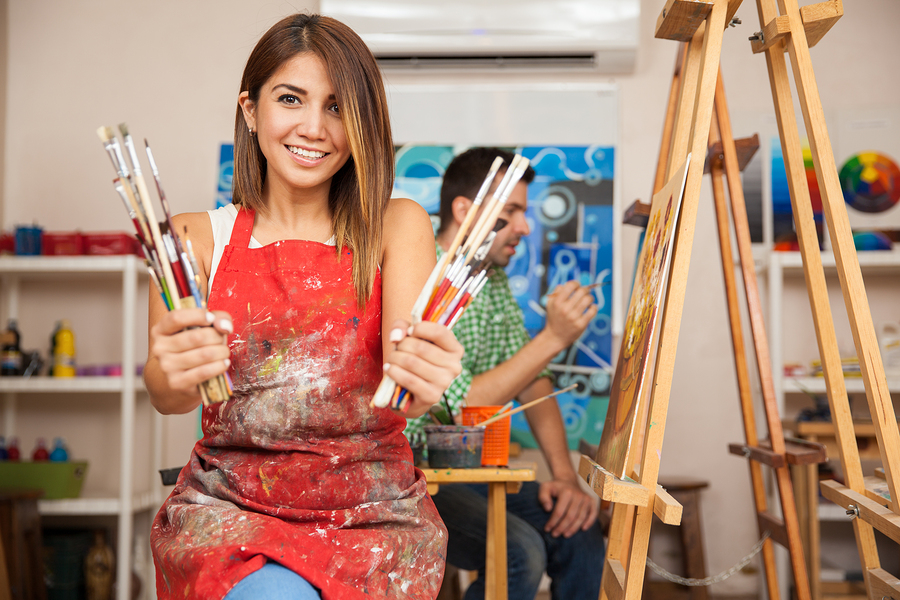How Does Art Therapy Help in Eating Disorder Recovery?
Expressing yourself creatively can help “shift” your thought life. When in recovery, therapeutic exposures are designed to help you recognize emotions and feelings when faced with a situation that is uncomfortable. Working with a therapist, this approach can help desensitize fears and/or emotions that may have triggered your eating disorder in the past. Gaining control and a sense of empowerment over the “feelings” is a very powerful tool in recovery. Expressing thoughts and controlling fears to shift your “thought life” can be incorporated into a recovery practice in several ways. One very effective method that helps shift to a more “right brain,” approach is art therapy.
What is Art Therapy
Art therapy incorporates visual arts, such as drawing, painting and other art forms with counseling and therapy. [1] According to the American Art Therapy Association, this mental health profession uses the creative process and the resulting artwork to explore feelings, reconcile emotional conflicts, foster self-awareness, manage behavior and addictions, develop social skills, improve reality orientation, reduce anxiety, and increase self esteem.[2]
When used in conjunction with other therapeutic exposures in recovery, it can help you shift from explaining feelings to actually feeling them, moving beyond verbal expression into something that is more visual. Using art forms as a means of expression can also provide a safe place to explore ways to manage feelings and possible triggers.
You do not have to be a seasoned artist to implement this practice into your life. In fact, the intention is not to explore your art/visual skills in any way, shape or form. The intention is to help improve and restore a sense of personal well-being to express things that words simply cannot.
It should be noted that art expression is indicative of a person’s culture and understanding of their world. There are no hard and fast rules for all individuals. A visual expression is personal and should be viewed as such.
How Art Therapy Can Be Helpful
There are professional art therapists and mental health professionals who implement this style of therapy with patients within their practices. A quick google search will provide many therapists in your area who specialize in this therapeutic exposure. It’s important to note that when art therapy is combined with other therapeutic exposures in eating disorder recovery, the combination can be a very healing process.
There are no rules or restrictions to getting started. Implementing this “right brain” practice can take many forms within your recovery, and you don’t need to make a trip to the art supply store to reap the benefits of this exercise at home. Letting your feelings and emotions inspire you to express yourself visually can be very liberating. Creating art is a process in which you can express your emotions in a more tangible way, versus “talking” about them.
How to Implement Art Therapy in Recovery
An art therapist professional may suggest many different art forms and mediums to help with expression of feelings and emotions. Expressions like: journaling; focused doodling; zentangle; painting; ceramics and drawing, even if it’s stick figures, are all expressive ways to unleash emotions and open up the right brain a bit.
One very well known art therapy method is body tracing. Body tracing is when you draw out what you think your body is, and the therapist traces your actual body over the top your drawing. Your perceived outline of your body is often larger than the tracing. An art therapist will utilize this visual expression as a tool to talk about the emotions and feelings you see. Expressing emotions through art journaling is also a symbolic way to detail your “thought life” and interrupt self-critical thinking patterns within a container for safe keeping — a journal.
Here’s a great way to implement this into a daily practice that can be documented in your journal, art journal or sacred space of your choosing. This idea (with a little twist) comes from Australian Art Therapist, Sheree Sams, who is a featured guest blogger on the Art Therapy Blog.
- On one side of the paper (or journal), draw your body shape. Explore realistic and non-realistic self-concepts you have about size. Document your notes on the page so that you can express the way you feel.
- On the other side, draw your heart and surround it with words of encouragement that symbolize joy and light. This could be words of encouragement that have been shared with you. It can also be positive words, feelings and/or emotions that you perceive about yourself.
This simple, expressive practice can help you acknowledge your feelings and emotions by putting words and images together for reflection and exploration. These artful expressions, when done regularly, can provide you with deeper understanding over your emotions through your recovery process, week over week. When you look back on these works and reflect, you will be able to let your feelings and emotions inspire you to take action.
Art Expression “Looking Forward”
There is a point within the recovery process where you are looking forward, making plans and using learned tools to create structure within your day. Art expressions can be very helpful during this phase in the form of a vision board.
A vision board is a tool used to help clarify, concentrate and maintain focus on a specific life goal. Again, no artistic talents or added supplies are needed. A vision board can be any sort of board or art journal that you use to display images representing the kind of life you want to live.
Here are some ideas to help you get jumpstarted:
- Gather and collect magazines, color combinations, motivational quotes, words and more. Be mindful of images that set up cultural ideals and expectations that are not “true” or in-line with your thoughts.
- Cut the images and words out and place them on a poster board, art journal, or sacred space that you choose.
- Listen to what your heart is saying and let your creativity take over. Don’t worry if the imagery and words go together, fit together, have same color combination, etc. It’s your board. It’s your space. It’s perfectly perfect just the way it is.
- Allow yourself to organize your board or art journal in a way that speaks to you.
- Keep it in a space where you can visit with it often as a reminder of your strength and empower you to continue on your healing journey.
- Have fun with it!
Greta Gleissner is the Founder of Eating Disorder Recovery Specialists, a nationwide network of eating disorder treatment specialists that provide meal coaching and recovery skills such as CBT, DBT, ACT, MI, etc. EDRS works alongside treatment programs, teams and families to provide transitional aftercare support for post-residential treatment clients.
Resources:
[1] https://www.eatingdisorderhope.com/treatment-for-eating-disorders/types-of-treatments/art-therapy
Other Resources:
https://www.arttherapyblog.com/mental-health/eating-disorder-therapy-art/#.WJILhRDXPaU
Body Mapping:
https://www.arttherapyblog.com/videos/art-therapy-aids-girl-with-eating-disorder/#.WJILthDXPaU



